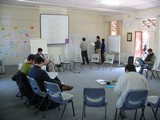Blog
Subscribe
Join over 5,000 people who receive the Anecdotally newsletter—and receive our free ebook Character Trumps Credentials.
Categories
- Anecdotes
- Business storytelling
- Collaboration
- Communication
- Corporate Storytelling
- Culture
- Decision-making
- Employee Engagement
- Events
- Fun
- Insight
- Leadership Posts
- News
- Podcast
- Selling
- Strategy
Archives
- March 2024
- December 2023
- November 2023
- October 2023
- September 2023
- August 2023
- July 2023
- June 2023
- May 2023
- April 2023
Years
A powerful intervention: Silence
 When I first saw Brian Bainbridge run an Open Space Technology workshop I was impressed most by his use of silence. I know that in public speaking using silence, or pause, is a powerful way to bring the audience together. To really get their attention.
When I first saw Brian Bainbridge run an Open Space Technology workshop I was impressed most by his use of silence. I know that in public speaking using silence, or pause, is a powerful way to bring the audience together. To really get their attention.
It is not surprising that many people feel uncomfortable with silence within groups, especially if you are the “leader” or “facilitator”. As Catherine Durnell Cramton has written in an article called “Finding common ground in dispersed collaboration”, silence has meant all of the following at one time or another:
- I agree
- I strongly disagree
- I am indifferent
- I am out of town
- I don’t know how to address this sensitive issue
- I am busy with other things
- I did not notice your question
- I did not realise that you wanted a response
Recently reading Practical Facilitation I came across the concept of “Bending Space and Time”. Here the author discusses how a storyteller can move the group (or listener) into a different time and space by the use of extremely long pauses.
I feel that the real power of silence, for a leader or facilitator of a group, is to really get a chance to listen to the group. To see what wants to emerge from within the group. Too often the facilitator or group leader is looked to for all the answers when, really, the group just needs time to look within.
About Andrew Rixon
Twitter •